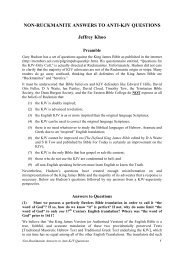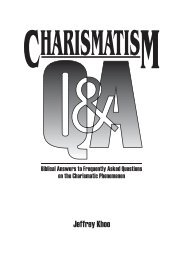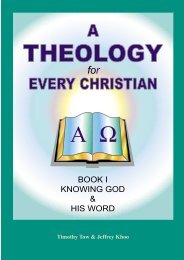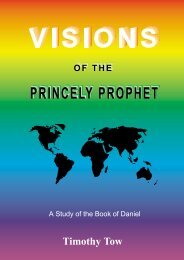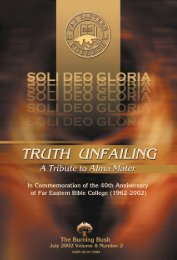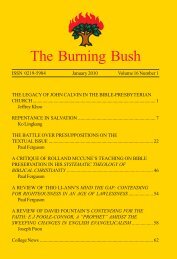Biblical Separation Defended - Far Eastern Bible College
Biblical Separation Defended - Far Eastern Bible College
Biblical Separation Defended - Far Eastern Bible College
- No tags were found...
You also want an ePaper? Increase the reach of your titles
YUMPU automatically turns print PDFs into web optimized ePapers that Google loves.
case readily be substantiated by a list of ignored errors. On the otherhand the entire New Testament, including especially the Sermon on theMount, Matthew 23, many of the parables, and the Lord’s constantdialogue with His enemies as well as with His disciples providescountless instances of the Lord’s correcting and rebuking errors ofmora1ity and doctrine.The Lord’s correction of various types of errors in different waysstands out in the New Testament. In John 11:40 Jesus is seen gentlycorrecting Martha’s error in protesting to the removal of the stoneguarding Lazarus’ tomb; in John 13:38 the Savior gently but firmlycorrects Peter’s error of self-confidence by foretelling to Peter his futurethreefold denial of his master; and numberless similar incidents could betabulated which demonstrate Jesus’ gentle but firm correction of theerrors of His own flock. In John 16:12 Jesus tells the disciples, “I havemany things to say unto you, but ye cannot bear them now,” thusinforming the reader that certain errors were not corrected at once, butthe all-wise Christ looked for the most auspicious time to correctmistaken ideas. This usually was immediately after the error, but onsome of the deeper theological concepts Christ waited until after thedisciples had witnessed His resurrection.In the famed Sermon on the Mount, which is cited by so many asthe pure example of positive teaching in contrast to negativism, Christrepeatedly uses the formula, “Ye have heard . . . but I say unto you”(Matt. 5), and is seen to correct error after error which had crept intoRabbinical Judaism by directly citing the error, exposing itsshortcoming, and by teaching the truth. In each of these sayings, as wellas in others in Matthew 6 and 7, Christ is directly contradicting theteachings of erring Rabbis and is doing the very opposite of ignoringerror!The prime example of all, however, wherein the Lord did not ignoreerror was in His relations with the unbelieving hypocritical falseprophets of His day. In Matthew 23 His severe denunciation of the errorsof the Pharisees and of the Pharisees themselves wherein He cites themas children of hell (v. 15) and pronounces an eightfold “Woe” uponthem, displays the opposite of one who ignores error! This is especiallytrue in view of his citation of particular errors before each of His several81




